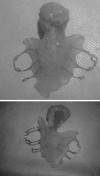Prosthetic Rehabilitation of a Congenital Soft Palate Defect
- PMID: 26199512
- PMCID: PMC4501982
- DOI: 10.1007/s13191-012-0225-7
Prosthetic Rehabilitation of a Congenital Soft Palate Defect
Abstract
Obturator is derived from the Latin verb obturate which means to close or to shut off. This definition provides an appropriate description of the objective of obturation in patients with palatal defects. The obturator is often helpful in improving the speech of individuals with partial or total velar defects i.e. cleft of soft palate. Soft palate cleft is one of the most common cause of velopharyngeal incompetence, which is the functional inability of the soft palate to effectively seal with the posterior and or lateral pharyngeal walls. In maxillofacial prosthesis the clinician may have the responsibility for reestablishing palatopharyngeal integrity to provide the potential for acceptable speech. Here a case report has been presented in which palatal plate with a solid one piece pharyngeal obturator prosthesis has been used for rehabilitation of a dentulous patient having congenital soft palate defect using functional impression technique.
Keywords: Hypernasality; Pharyngeal obturator; Retention; Soft palate; Speech aid; Velopharyngeal (VP) insufficiency.
Figures













Similar articles
-
Treatment Option for Velopharyngeal Insufficiency: A Speech Aid.Int J Clin Pediatr Dent. 2024 May;17(5):601-604. doi: 10.5005/jp-journals-10005-2869. Int J Clin Pediatr Dent. 2024. PMID: 39355180 Free PMC article.
-
Prosthetic rehabilitation of velopharyngeal insufficiency: pharyngeal obturator prostheses with different retention mechanisms.Eur J Dent. 2010 Jan;4(1):81-7. Eur J Dent. 2010. PMID: 20046485 Free PMC article.
-
Palatopharyngeal obturator prosthesis - A substitute for a dynamic separator: A technique.J Indian Prosthodont Soc. 2022 Apr-Jun;22(2):200-204. doi: 10.4103/jips.jips_403_21. J Indian Prosthodont Soc. 2022. PMID: 36511032 Free PMC article.
-
Submucous cleft palate: diagnostic methods and outcomes of surgical treatment.Plast Reconstr Surg. 1996 Jun;97(7):1497-509. doi: 10.1097/00006534-199606000-00032. Plast Reconstr Surg. 1996. PMID: 8643740 Review.
-
Prosthetic Rehabilitation with Palatal Lift/Augmentation in a Patient with Neurologic/Motor Deficit Due To Cancer Therapy for Chondrosarcoma.J Prosthodont. 2019 Mar;28(3):234-238. doi: 10.1111/jopr.12990. Epub 2018 Nov 15. J Prosthodont. 2019. PMID: 30357985 Review.
References
-
- Thomas CA, Beumer J III (1979) Maxillofacial rehabilitation prosthodontic and surgical considerations, Ishiyaku EuroAmerica, St. Louis, pp 244–291
-
- Stewart KL, Rudd KD, Kubekar WA (2004) Clinical removable partial prosthodontics, 2nd edn. Ishiyaku EuroAmerica, Inc, Publishers, Tokyo, St. Louis, pp 635–665
-
- Aramany MA. Basic principles of obturator design for partially edentulous patients. Part I. Classification. J Prosthet Dent. 1978;40:54. - PubMed
-
- Paul G, Harlan B. A supportive type prosthetic speech aid. J Prosthet Dent. 1958;8:362–369. doi: 10.1016/0022-3913(58)90169-0. - DOI
Publication types
LinkOut - more resources
Full Text Sources
